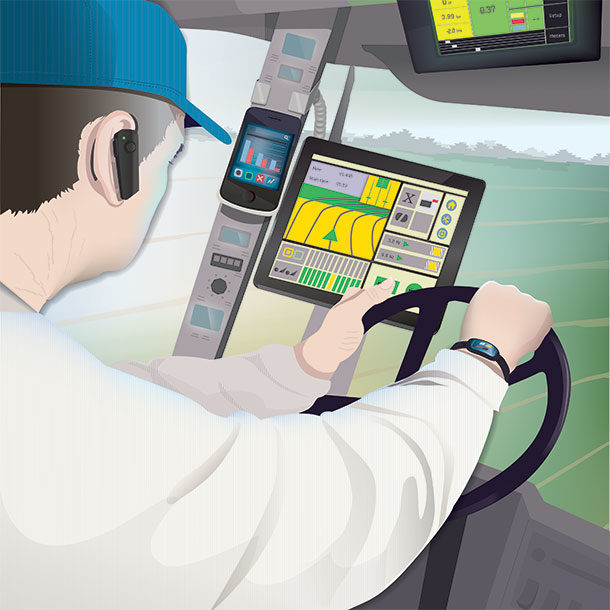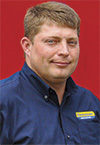Q. What makes a self-propelled windrower productive?
A. For commercial haymakers, productivity begins when a crop is mown, and the self-propelled windrower has always been at the forefront.
Its forward-looking operating position, combined with unsurpassed maneuverability, means operators are more likely to cut a full swath, operate at higher ground speeds, more easily avoid field obstacles and return to cutting quickly on headlands.
Today’s modern self-propelled windrower models are equipped with powerful diesel engines, advanced hydraulic drive systems and wide disc mower-conditioner heads. Speed is an essential element to self-propelled windrower productivity.
With that in mind, speed can only improve productivity so much before operating conditions begin to slow down production. With today’s powerful models, it’s essential to smooth out the rough spots to take advantage of the available power.
Self-propelled windrowers equipped with an excellent cab suspension system and independent air-ride rear axle suspension do just that. Suspension systems are not simply for mowing faster. These systems are also in place to reduce operator fatigue, which often means the operator can also mow longer, cutting more acres each day.
Q. How has auto-guidance changed modern hay production?
A. In years past, some producers thought of auto-guidance simply as taking the operator out of the equation. Today, many understand that these systems provide tangible benefits.
Auto-guidance in hay cutting applications simply streamlines the haymaking process. By minimizing the overlap between passes, operators are ensured of the most productivity pass-to-pass.
Something that might be overlooked by haymakers is the improvement in windrow or swath consistency provided by auto-guidance.
With auto-guidance, the operator can accurately take a consistent width of cut on each pass, improving the volume and consistency of hay in each windrow, which can shorten drying time and improve baling efficiency by providing maximum productivity.
As system accuracy has improved, it has freed up machine operators to pay close attention to monitoring the machine, avoiding obstacles and observing the cut and windrow quality.
Additionally, operator fatigue can be significantly reduced. We’ve heard many times from operators that they aren’t nearly as tired at the end of the day as they were before they had auto-guidance.
Q. What are the different types of auto-guidance options available?
A. Today, there are two primary types of guidance: Factory-installed solutions provided by the original equipment manufacturer, which are designed and integrated to work with a specific machine, and assisted steering auto-guidance solutions, provided aftermarket, which adapt to a machine without full integration.
The factory-integrated systems provide greater steering accuracy than aftermarket assisted steering systems. As critical to integration, the software package behind the auto-guidance system is specifically tailored to the vehicle dynamics of the manufacturer’s self-propelled windrower for responsive and accurate control.
Assisted steering auto-guidance solutions are available for many older machines and often use an electric motor to turn the steering wheel to provide vehicle control.
These systems have the advantage of being versatile because they can also work with other, multiple vehicles around the farm. Such assisted steering systems incorporate a powered friction wheel that simply turns the steering wheel controlling the vehicle.
There is another alternative that integrates more seamlessly into the vehicle’s steering column but has the disadvantage of not being easily moved between vehicles.
Beyond the system, the next most important factor is selecting a correction signal for accuracy. Wide Area Augmentation System or WAAS is a free signal available that provides pass-to-pass accuracy of 6 to 8 inches. However, there are several satellite-based correction signals also available by subscription for increased accuracy.
Today, the CenterPoint RTX correction signal offers a satellite-based correction signal with 1.5-inch pass-to-pass accuracy or greater. For precision work requiring sub-1 inch, repeatable accuracy RTK should be chosen, a system with a base station.
With the broad offering of correction signals, it’s important for producers to understand and to select the option best suited for them. The local dealer can often provide details on auto-guidance systems and correction signal options.
Q. What are some thoughts on round versus big square balers?
A. This is a question that depends greatly on the operation. There is a large difference in cost of a round baler versus the cost of a large square baler and the tractor required for each. Large square balers generally require a larger tractor than a round baler.
Round bales are typically used in applications where the bales will be used locally. Outside storage with minimal losses help drive the choice to round bale versus large square. Large square bales are better if over-the-road transport is required.
They are easier to stack on a truck, they better utilize the available space and more likely maximize the truck’s weight limit. Large square bales are also denser. There are additional factors as well, but it all comes down to what fits best in each individual operation.
Q. What is the importance of high bale density and consistent bale density?
A. Bale density is key in many aspects. When baling baleage, a dense bale means less oxygen in the bale, which will lead to better fermentation and higher-quality feed.
Dense bales mean fewer bales to move around; this becomes especially important when bales are transported over long distances where operators need to maximize weight. Dense bales stack better and hold their shape better over time.
Q. What are current thoughts on handling large round bales?
A. It’s important to get the bales off the field as quickly as possible and to pay close attention to limit the amount of traffic over the field. When wheel traffic damages alfalfa plants, they have to begin growing again from the tip of the shoots at the ground.
Therefore, minimizing stubble damage is one of the keys to overall productivity. If the bales are high-moisture bales for baleage, they should be wrapped as quickly as possible to start the fermentation process and preserve the forage.
Q. What are current thoughts on handling large square bales?
A. There are lots of choices out there, from self-propelled bale wagons that retrieve and stack (the choice of the commercial producer) to a skid steer with bale spear and wagons pulled by a tractor or pickup trucks.
Pull-type bale wagons that stack and retrieve are also a choice, a more economical solution compared to the self-propelled option. There are also accumulators available that can stack two bales and drop them in the field or drop three bales side by side for more efficient pickup later. ![]()
ILLUSTRATION: Illustration by Corey Lewis.
Phil Eby is a hay and forage specialist with New Holland.
Jordan Milewski is a crop preparation marketing manager with New Holland. Email Jordan Milewski.












